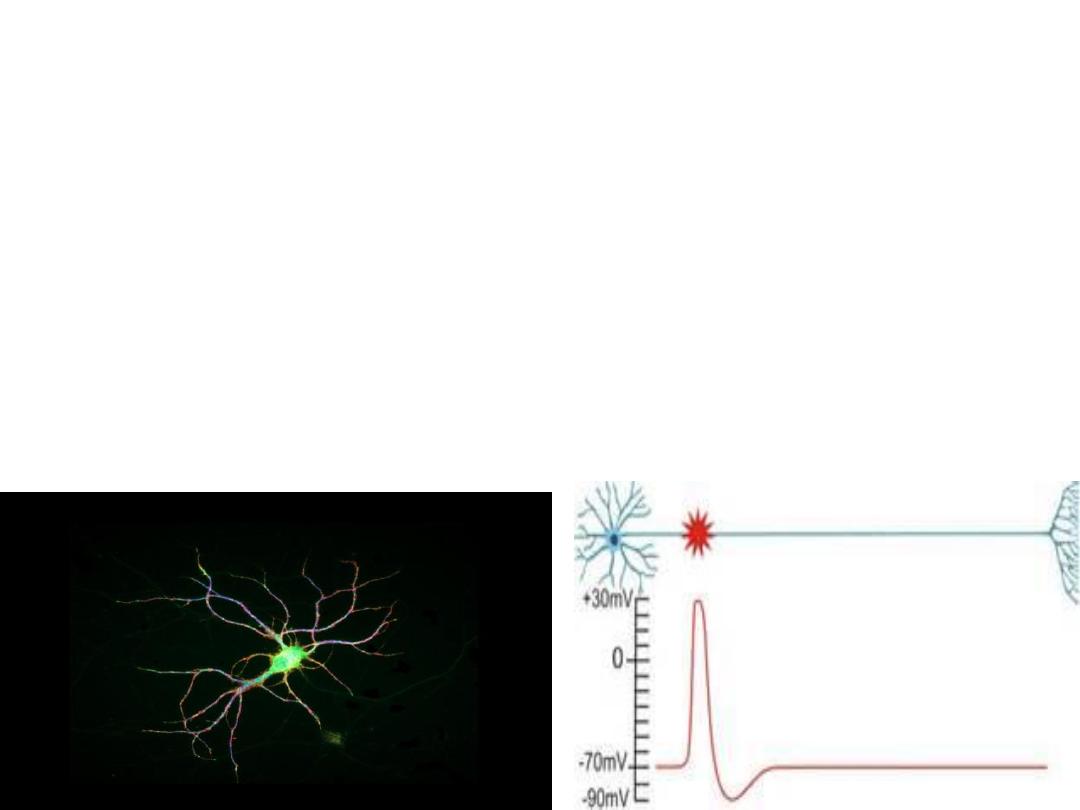
Action potential
( ionic basis,properties)
Lecture 3
Dr Hanan Luay

Objectives:
1-Define action potential.
2-List the successive stages of nerve action
potential and recognize their properties.
3-Draw a diagram showing action potential
stages.
4-Differentiate between a single axon and a
mixed nerve properties.
5- Describe the effect of changing ions
concentrations on membrane potential
6-Describe the properties of action potential.
7-Compare the conduction of nerve impulse
between mylinated and non mylinated fibers.

Nerve signals (are coded information)
transmitted by action potentials which
are rapid changes in the membrane
potential in response to stimulus that
spread rapidly along the nerve fiber
membrane.
Nerve action potential
:
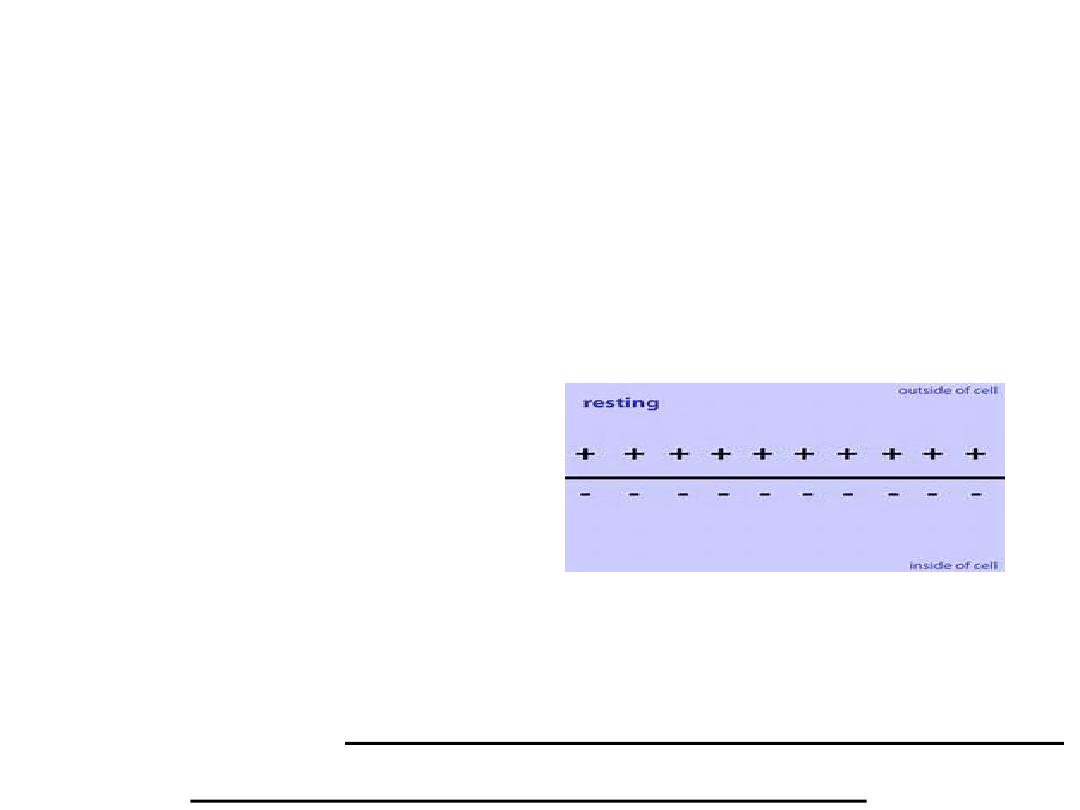
The successive stages in action
potential are as follows:
1-The resting stage
. The membrane is
polarized,
before the action potential begins . There is brief
irregular deflection of the baseline (leakge of ions),
called the stimulus artifact.
2-The latent period (latency
). Is also an isoptential
state, the membrane here is
still polarized
. It is the
from the beginning of stimulation to
interval starting
.
the beginning of potential changes
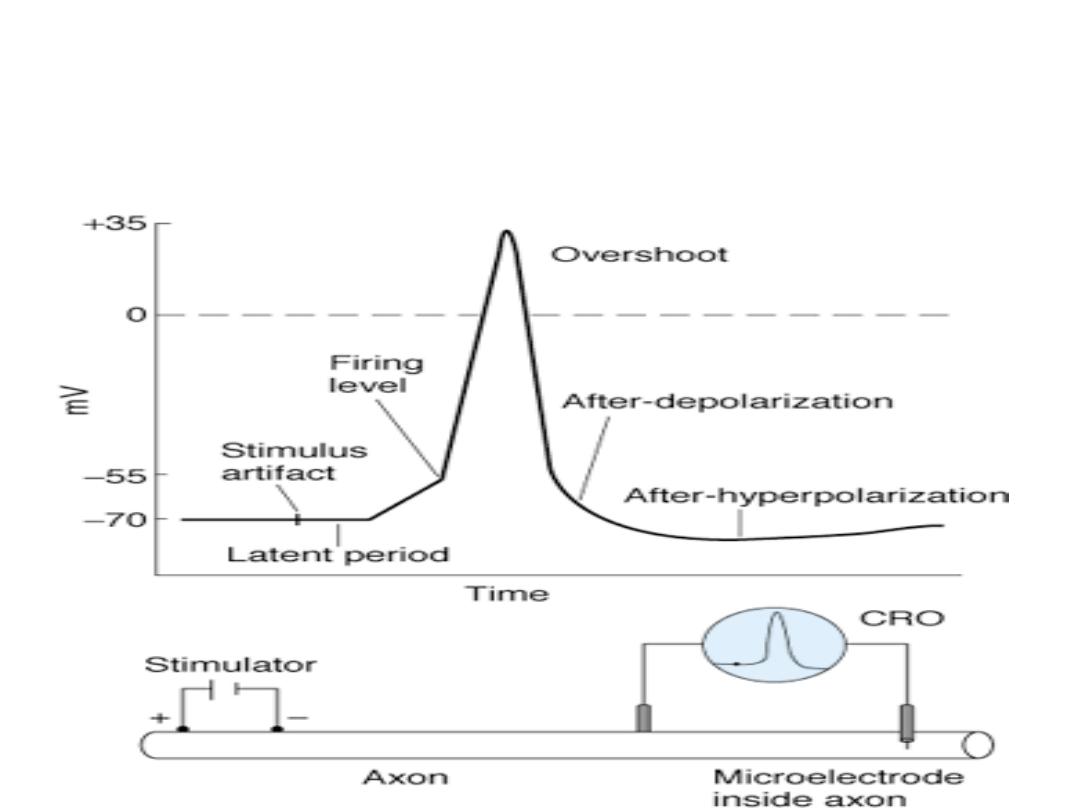
Latent period is Proportional to 1-The distance
between the stimulus site and the recording site.
2- Inversely to the conduction speed of the axon
.

3-The depolarization stage.
-
Opening of Na ion channels.
-The potential increases rapidly in the positive
direction.
-There will be overshooting beyond the zero level.
The overshooting not exceeds 35mv, and Na ion
will not reach its equilibrium potential because:
-The concentration gradient for Na ions will be
reduced.
-The direction of the electrical gradient will be
reversed.
-The Na ion channels will close or inactivated rapidly.

4-The repolarization stage.
Na ion channels begin to close and the K ion channels
open.
( K ion channels delayed after that of Na ), then
rapid diffusion of K ions to the exterior.
The repolarization is rapid until 70%, after that it becomes
slower until reaching the resting membrane potential.
The sharp rise and the rapid fall of the action potential
is called the
spike potential
The last 30% of repolarization which is slow is called
after depolarization.
The membrane potential will not stop at the resting
membrane potential (-70 mv), but reduces further 1-2
mv below it, then return to the resting potential ,this
period called after hyperpolarization
.
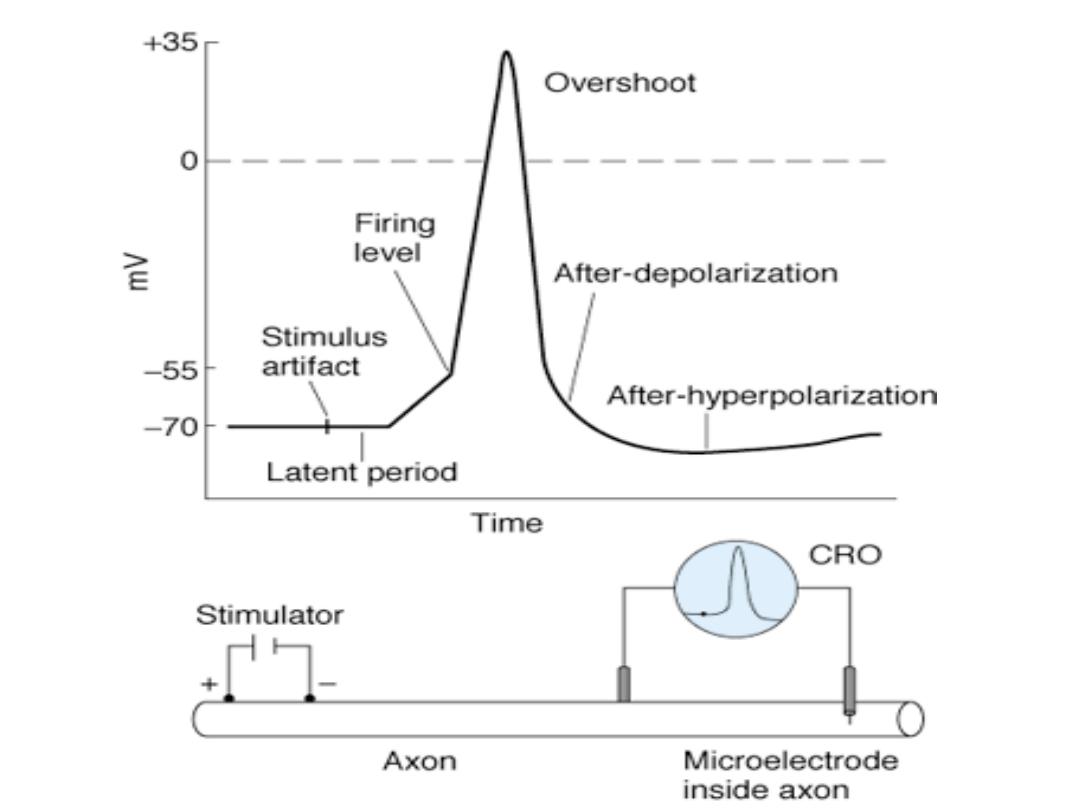
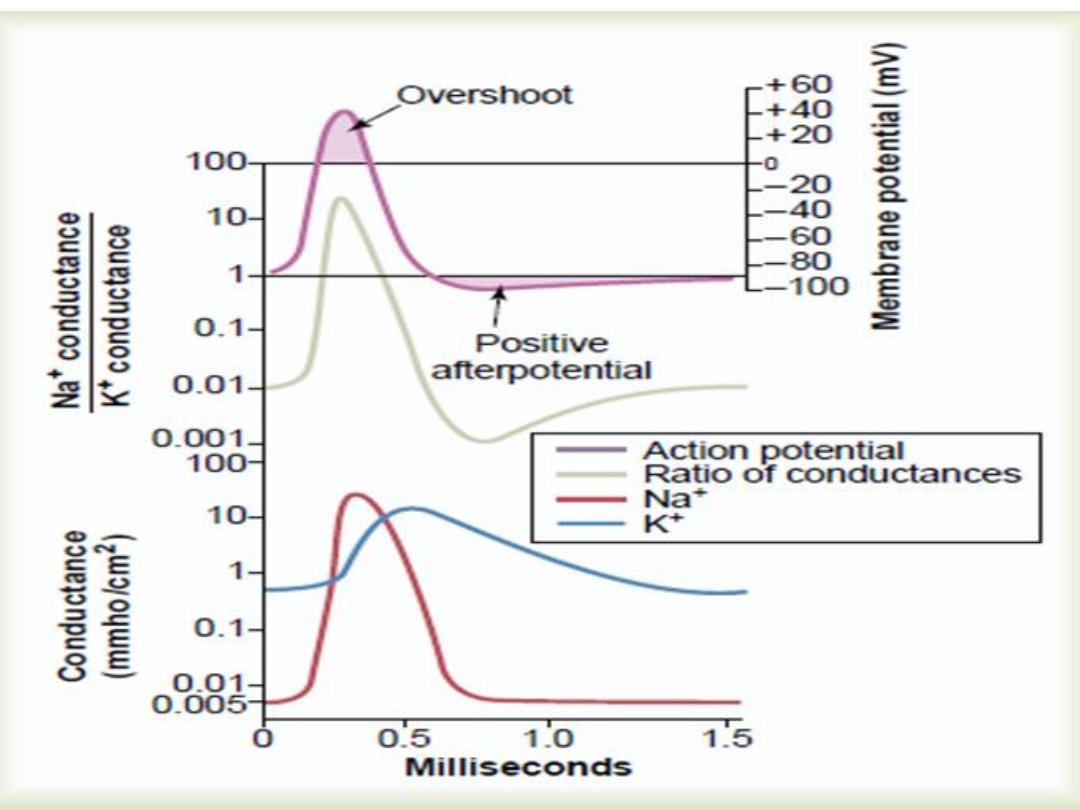
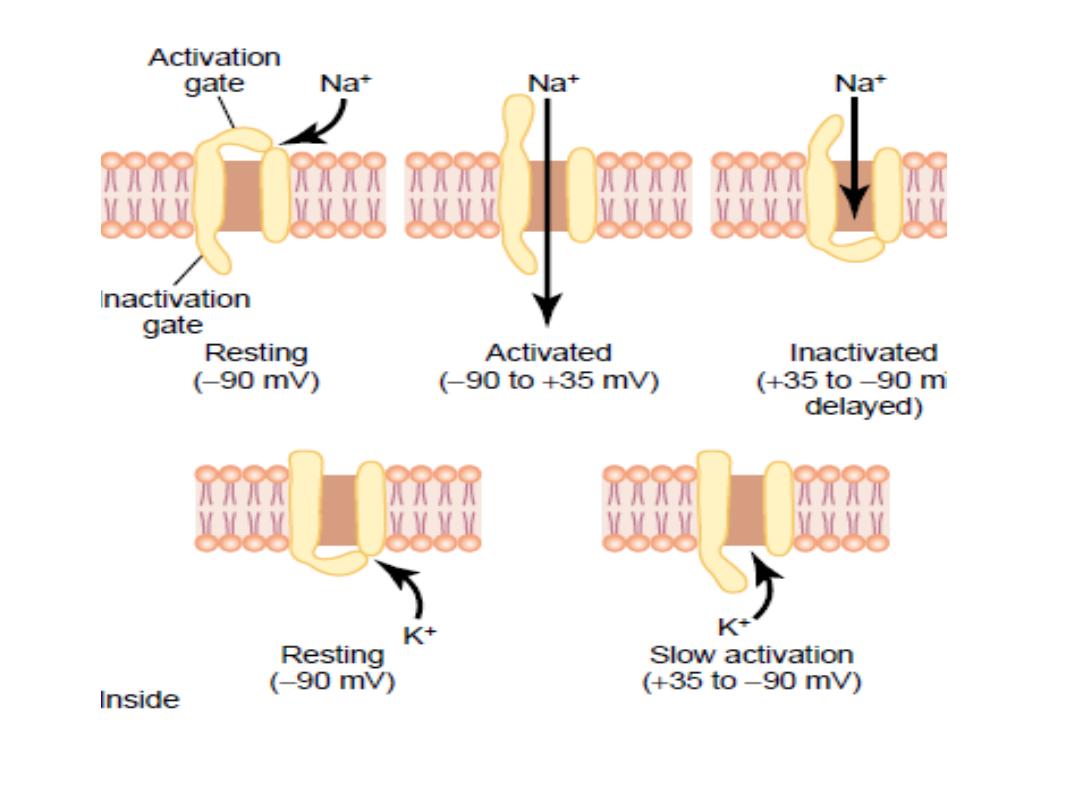
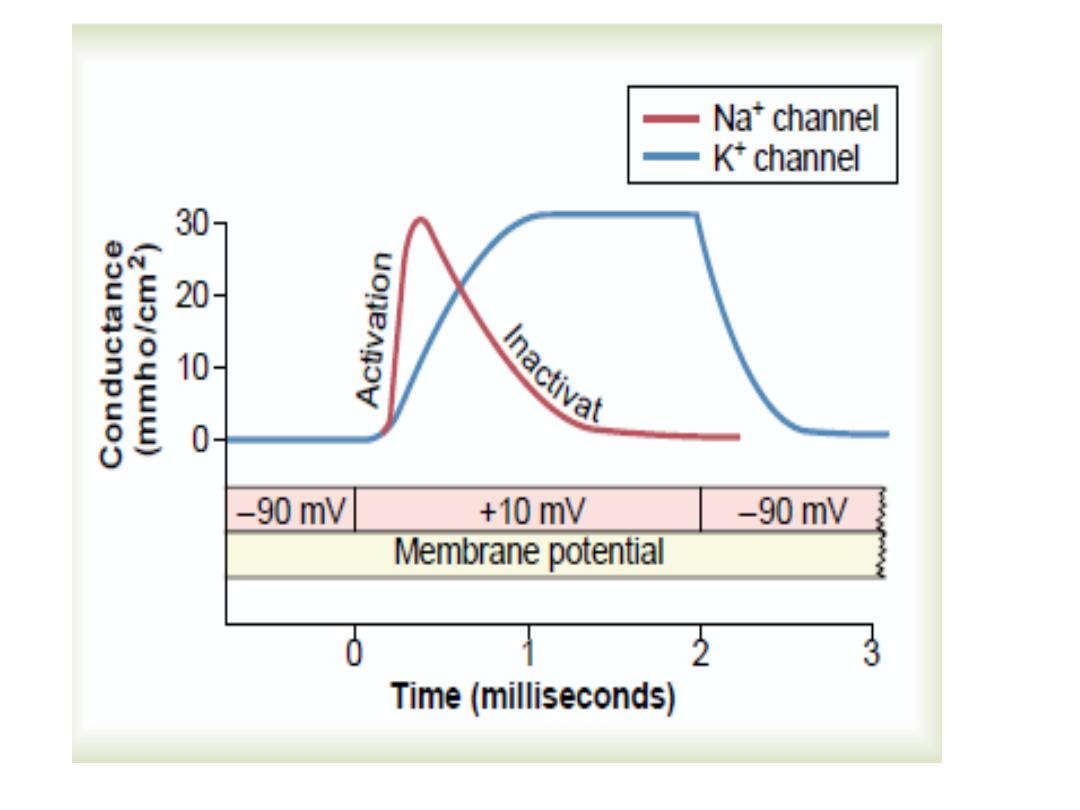

Notice that
active transport processes are not
directly involved in the production of an action potential;
both depolarization and repolarization are produced by the
diffusion of ions down their concentration gradients
,
Thus a neuron poisoned with cyanide cannot produce ATP,
can still produce action potentials for a period of time.
After a while, the lack of ATP for active transport by the
Na/K pumps will result in a decline in the concentration
gradients, and therefore in the ability of
the axon to
produce action potentials.
This shows that the Na/K pumps are not directly
involved; rather, they are required to maintain the
concentration gradients needed for the diffusion of Na
and K during action potentials.

Decreasing the external Na
+
concentration
↓
Decrease the action potential
little effect on the resting membrane potential,
since the permeability to Na
+
at rest is relatively
low.
Among the most important stabilizers are the
local
anesthetics
. Most of these act directly on the
activation gates of the Na⁺ channels, making it
difficult for these gates to open, thereby
reducing membrane excitability and block the
conduction of action potentials
.

Increasing the external K
+
concentration
↓
Decreases the resting potential i.e
becomes less negative
( threshold is less).
WHY?

Decrease in extracellular Ca
2+
concentration
↓
Increases the excitability of
nerve and muscle cells
Because Ca ions are necessary to close the Na
ion channels ,so if Ca ions are deficient ,Na ion
channels remain open (spasm in the muscle or
tetany). Conversely, an increase in extracellular
Ca
2+
concentration "stabilizes the membrane"
by decreasing excitability
.

Orthodromic & Antidromic Conduction
In a living animal, impulses normally pass in one
direction only, i.e, from synaptic junctions or receptors
along axons to their termination.
Any antidromic impulses that are set up fail to pass the
first synapse they encounter and die out at that point.
WHY?
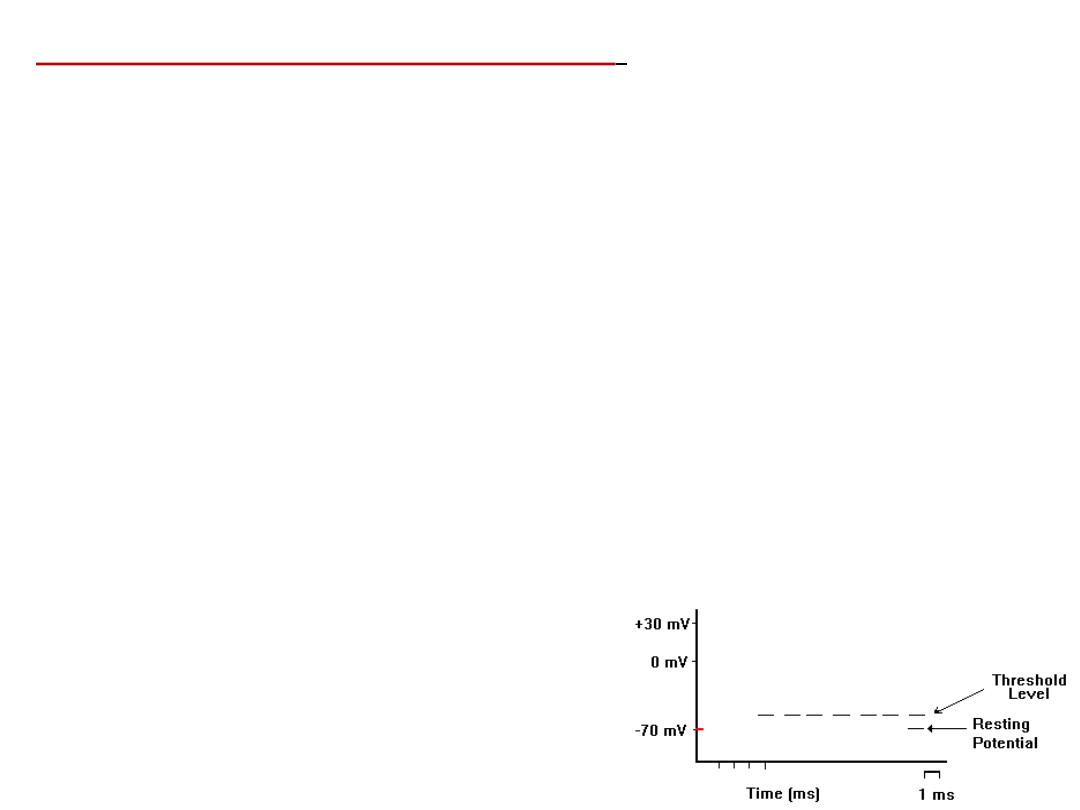
Properties of the action potential
:
1 – Threshold
. the minimal intensity of the stimulus required to
excite the nerve and to produce action potential.
If the stimulus is weak, it will disturb the membrane locally and called
local potential, but the intensity of the local potential must rise to the
threshold level before the action potential is set off.
2- Self –reinforcement
(regeneration). the action potential has
the same size and shape without any energy loss.
3- The all or none law.
The action potential fails to occur if the
stimulus is subthreshold in magnitude (the none part), and it
occurs if the stimulus is at or above threshold intensity. Further
increases in the intensity of a stimulus produce no increment in
the action potential, because The channels are only open for a
fixed period of time and then inactivated,.

4-The refractory period
(RP),absolute and relative. it is the
time or interval during which the
axon or nerve fiber is incapable of
firing a second action potential
when a second stimulus is applied.
Absolute RP.
Relative RP.

The period from the firing level up to the end of the first
third of repolarization, the membrane is completely
refractory to further stimulation. This is called the
absolute refractory period, and no stimulus no matter
how strong can excite the
membrane and initiate an
action potential. Why?
All Na⁺ channels are inactivated and no stimulus can
reopen them, until the membrane is repolarized
.
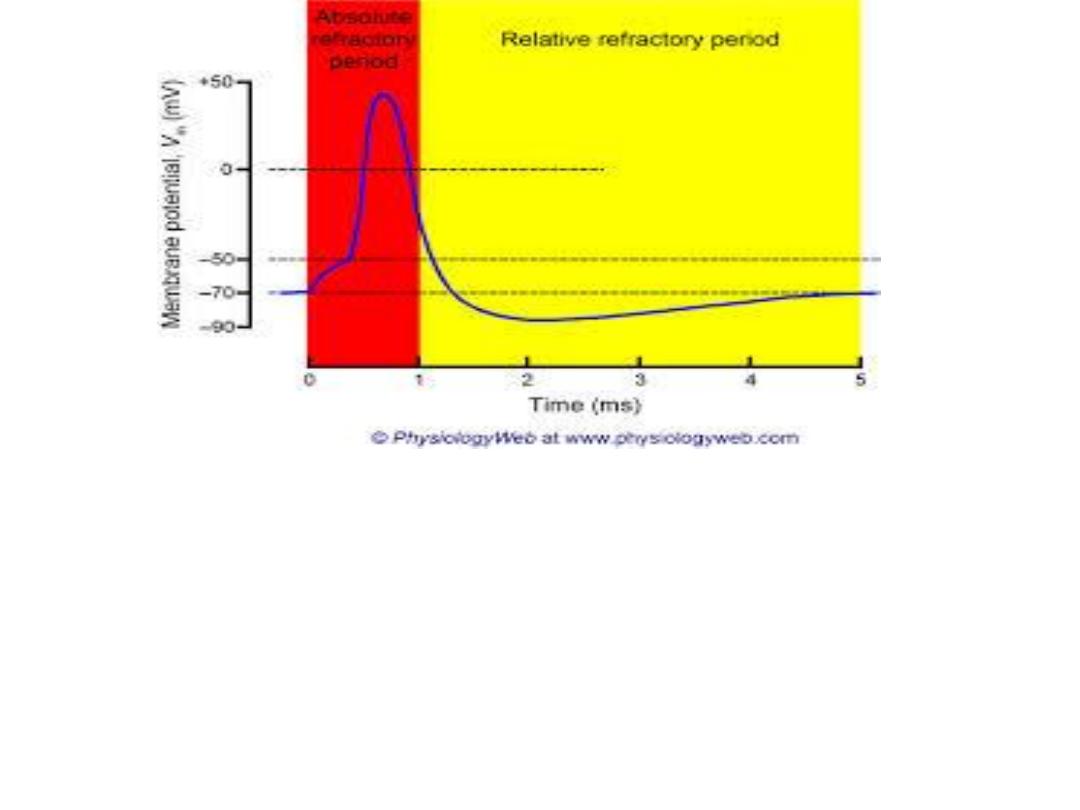
From the end of the absolute refractory period, up to the start of after
hyperpolarization, the membrane is able to fire second action potential but with
stronger stimulus than normally is required, this is called the relative refractory
period which occurs because:
a- Some Na⁺ channels during this period are opened and others are closed, so a
stronger stimulus than normal is needed to open these channels required to
trigger an action potential.
b-
During the relative RP, the conductance to K⁺ is increased which opposite the
depolarization of the membrane and so stronger stimulus is needed.
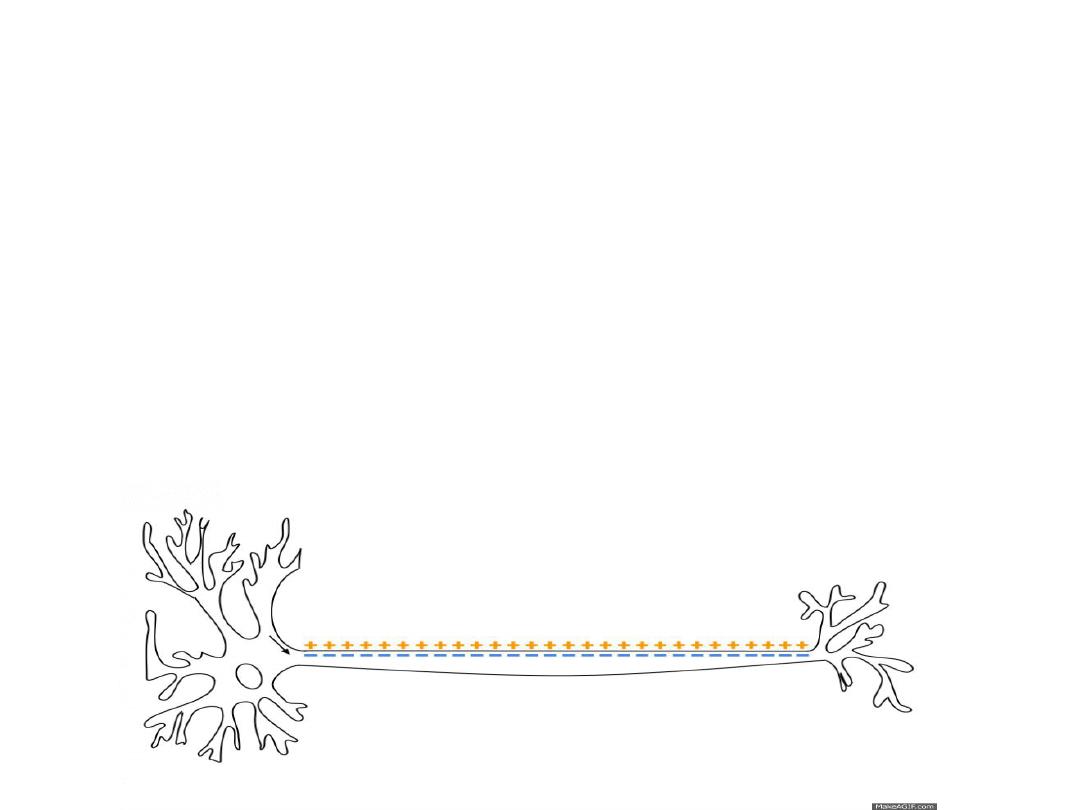
5-Propagation
of
action
potential.
The nerve cell is polarized at rest, when a
point on the membrane is stimulated, the
polarity of the membrane is abolished and
reversed .The action potential at one point will
excite the adjacent portions of the membrane
which leads to propagation of action potential.
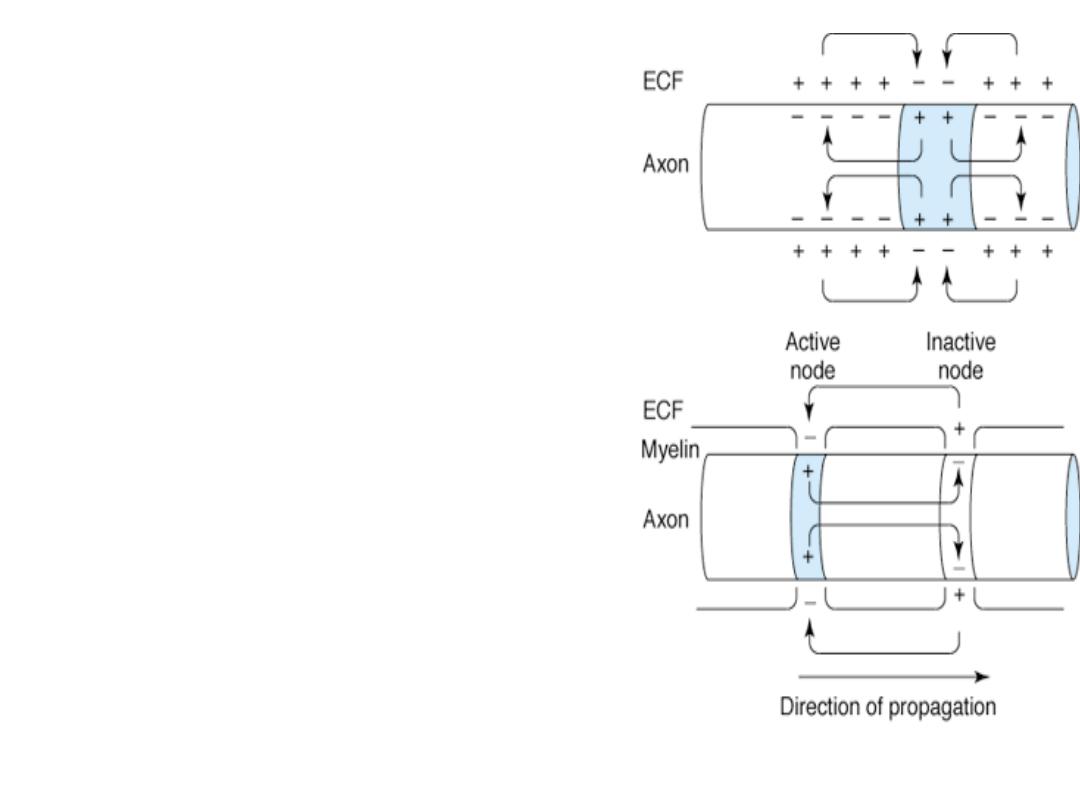
A- Unmylinated fibers
-Current sink.
If the nerve excited , permeability
to Na⁺→local circuit of current
flow from the depolarizing area to
the adjacent area, so the positive
charges from the area in front
and behind the action potential
will flow into the area of
negativity represented by the
action potential, this sequence of
events moves regularly along the
unmylinated axon to reach its end
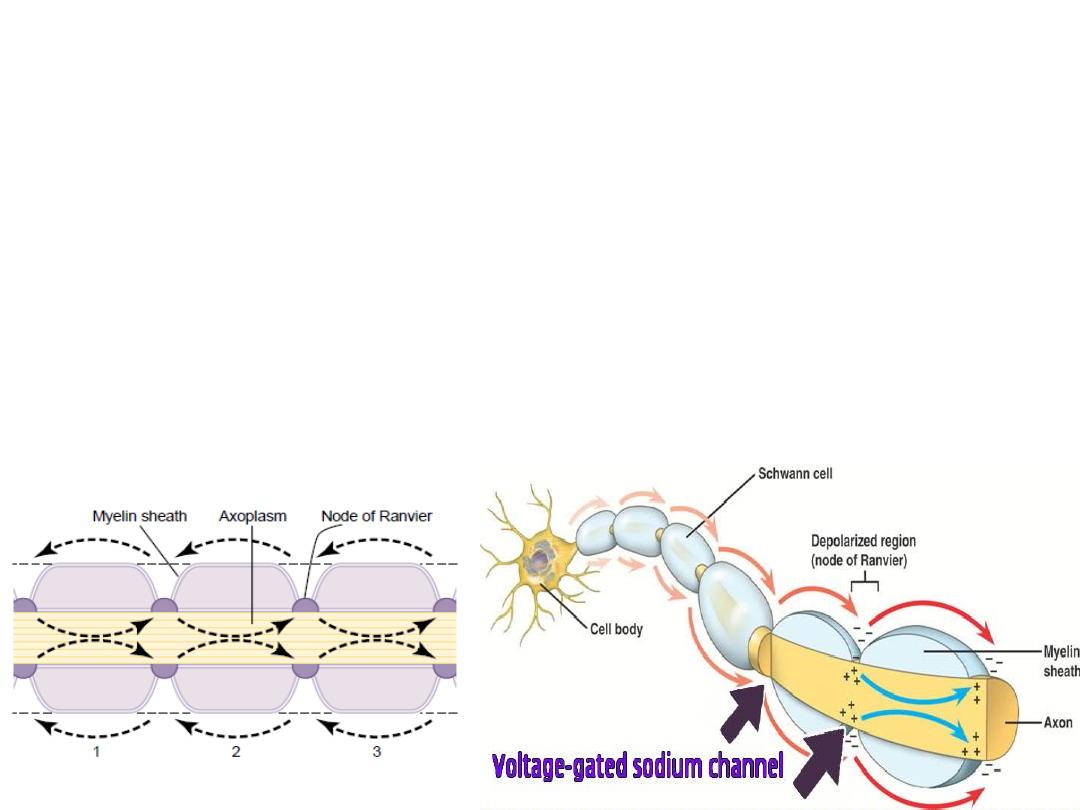
B-Mylinated fibers
-Salutatory conduction
In mylinated nerve fiber, conduction also depends on similar
pattern of a circular current flow, but since myline is an effective
isolator, the current flow through it is negligible, and instant
depolarization jump from one node to the other (i.e. the
electrical currents flow from through the surrounding
extracellular fluid , as well as through the axoplasm inside the
axon from node to node ( high concentration of Voltage-gated
Na
+
channels
).

6- Accommodation to slow depolarization (failure
to fire despite high voltage):
Slowly rising currents fail to fire the nerve because
the nerve adapts to the applied stimulus.
During slow depolarization, some of the Na channels which
are opened will have enough time to close before the
threshold potential being reached, in addition K ion
channels will have enough time to open during slow
depolarization, this tends to repolarize the membrane
and the threshold will not be reached
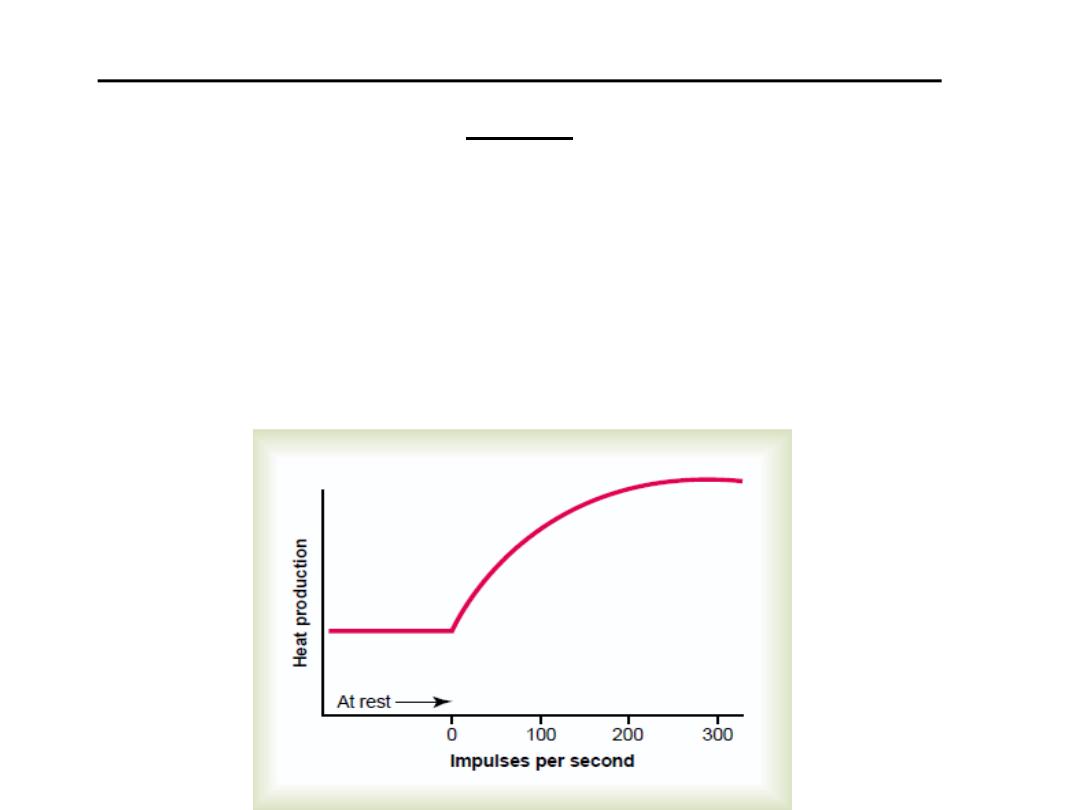
Energy source and production in the nerve
fiber:
70% of the energy is used to maintain polarization of
the membrane by the action of Na
+
-K
+
ATPase. During
maximal activity, the metabolic rate of the nerve
doubles the normal.
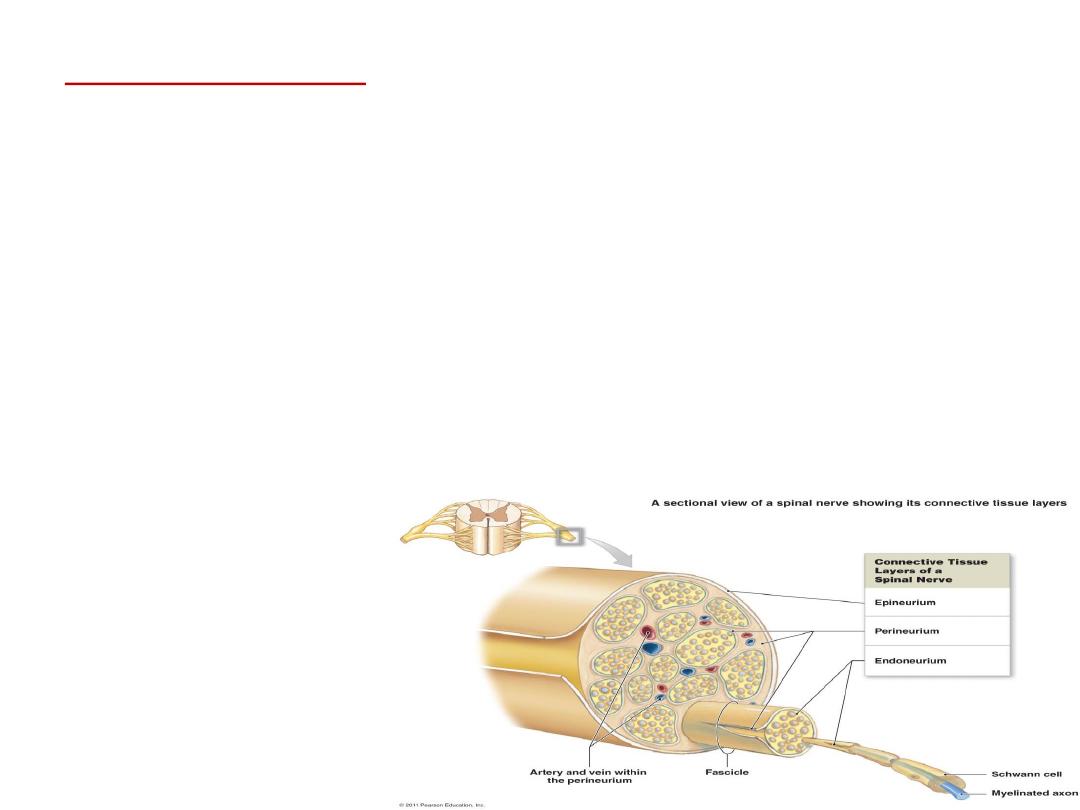
The mixed nerve:
Peripheral nerves in mammals are made up of many axons
bound together
With subthreshold stimuli, none of the axons are stimulated.
When the stimuli are of threshold intensity, axons with low
thresholds fire and a small potential change is observed.
As the intensity of the stimulating current is increased, the axons
with higher thresholds are also discharged.
IT DOES NOT OBEY THE ALL OR NONE LAW.
Supramaximal stimuli produces no further increase in the size of
the observed potential.
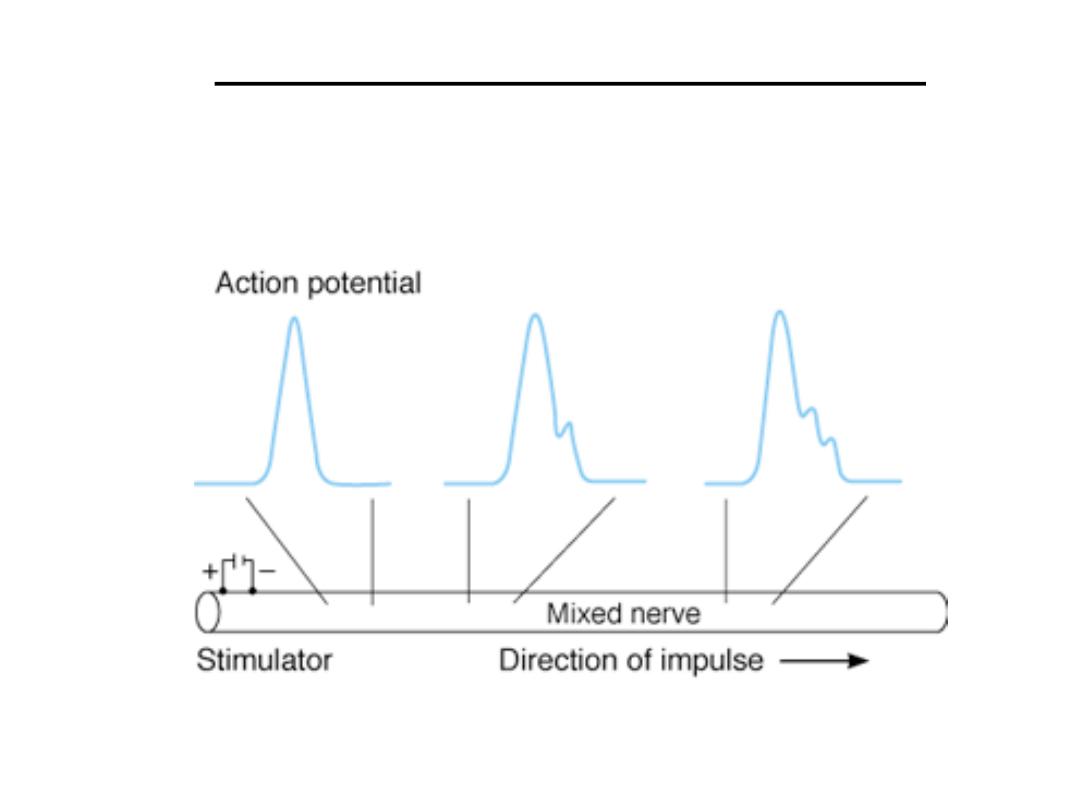
Compound Action Potentials
Appearance of multiple peaks in the action
potential.

Mixed nerve is made up of families of fibers with
various speeds of conduction. Therefore, when all
the fibers are stimulated, the activity in fast-
conducting fibers arrives at the recording
electrodes sooner than the activity in slower fibers;
In addition to that the distance from the
stimulating electrode affects the recording also.

Summary :
-Nerve signals (are coded information) transmitted by action
potentials.
-Serial stages of action potential occurs :
Depolarization …mainly influx of sodium ions
Repolarization …mainly efflux of potassium ions.
-Action potential has several properties.
-Changes of ion concentrations in the extracellular fluid may
affect the resting and action potential.
-Mixed nerves have compound action potentials.
